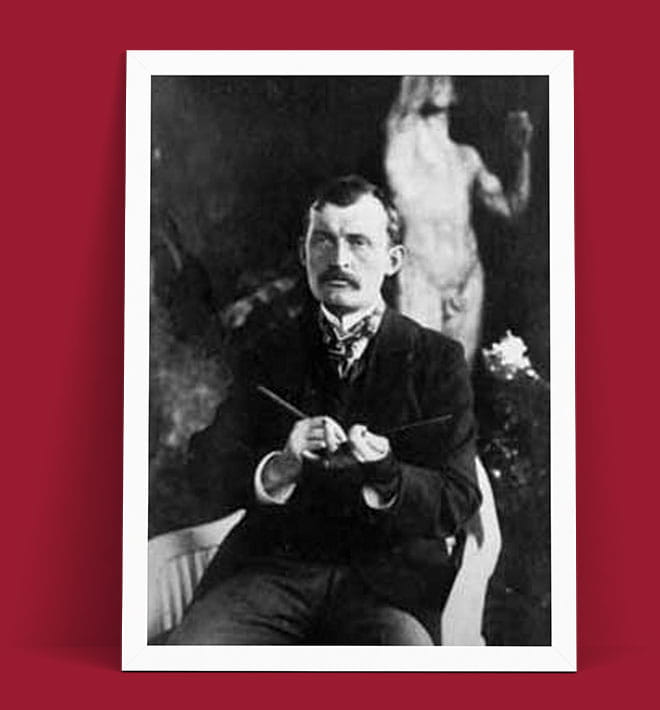Early Life and Influences
Born on December 12, 1863, in a farmhouse in the village of Ådalsbruk in Løten, Norway, Munch was the second of five children. His father, Christian Munch, was a deeply religious military doctor, and his mother, Laura Catherine Bjølstad, was artistically inclined, possibly nurturing Edvard's early interest in art. The family moved to Oslo (then called Christiania) in 1864. Tragedy struck early in Munch's life; his mother died of tuberculosis in 1868 when he was just five years old, and his beloved sister, Johanne Sophie, succumbed to the same disease in 1877 at the age of 15. These experiences of illness and death profoundly impacted Munch's psyche and later influenced his artistic themes. Often ill himself, Munch would draw to occupy his time during periods of convalescence, laying the foundation for his future career.
Munch's formal art education began at the Royal School of Art and Design in Kristiania (now Oslo), where he studied under sculptor Julius Middelthun and painter Christian Krohg. Krohg, a leading figure in the Norwegian art scene, was part of the Kristiania Bohème, a circle of writers and artists who opposed bourgeois norms and embraced free love and radical ideas. This association exposed Munch to new philosophies and artistic approaches, encouraging him to move beyond traditional naturalism. A significant turning point in his artistic development occurred during a trip to Paris in 1889, where he encountered the works of the Post-Impressionists, particularly Paul Gauguin and Henri de Toulouse-Lautrec. These artists' use of color and form to convey emotion resonated with Munch and influenced his departure from realism toward a more expressive style.
Artistic Evolution and Style
Munch's art is characterized by its expressive line work, vivid colors, and exploration of themes such as anxiety, love, and death. His technique often involved dramatic lines and a deliberate use of color to convey deep emotional resonance. This approach not only set him apart from his contemporaries but also positioned him as a precursor to German Expressionism. Munch's early works were influenced by the Symbolist movement, which sought to represent ideas and emotions rather than realistic depictions. He experimented with various styles, including Impressionism and Post-Impressionism, but ultimately developed a unique approach that prioritized the expression of internal states over external reality. His paintings often feature distorted forms and exaggerated colors to evoke psychological tension, reflecting his belief that art should depict the emotional and spiritual aspects of human experience.
"The Scream" and Its Significance
In 1893, Munch created "The Scream," a composition that has become one of the most iconic images in art history. The painting depicts an agonized figure against a tumultuous sky, capturing an intense moment of existential dread. Munch described the inspiration behind the piece in his diary:
"I was walking along the road with two friends—the sun went down—I felt a gust of melancholy—suddenly the sky turned a bloody red. I stopped, leaned against the railing, tired to death—as the flaming skies hung like blood and sword over the blue-black fjord and the city—My friends went on—I stood there trembling with anxiety—and I felt a vast infinite scream [tear] through nature."
This personal experience of overwhelming anxiety is vividly conveyed through the painting's swirling lines and stark color contrasts. The sky is rendered in intense reds and oranges, while the landscape features cooler tones, creating a visual tension that mirrors the emotional turmoil of the central figure. The figure itself is depicted with a distorted, almost skeletal face, hands clasped to its head in a gesture of despair. This abstraction serves to universalize the emotion, allowing viewers to project their own feelings onto the image. "The Scream" has been interpreted as a profound representation of universal human anxiety, resonating deeply with audiences worldwide.
Legacy and Influence
Munch's exploration of psychological themes and his innovative use of color and form had a significant impact on the development of modern art, particularly on German Expressionism. His works continue to be celebrated for their emotional depth and have been exhibited globally. Notably, the National Gallery of Australia recently acquired his 1918 painting "Man with Horse," marking a monumental addition to their collection. Munch's legacy endures as his art continues to evoke profound contemplation of the human experience.
Throughout his career, Munch produced numerous other significant works, including "The Sick Child," "Madonna," and "The Dance of Life," each exploring complex themes of illness, sexuality, and existential reflection. His innovative techniques extended beyond painting to include printmaking, where he experimented with etching, lithography, and woodcuts, further expanding his expressive capabilities. Munch's willingness to delve into the depths of human emotion and his ability to translate these feelings onto canvas have cemented his status as a pivotal figure in art history.


